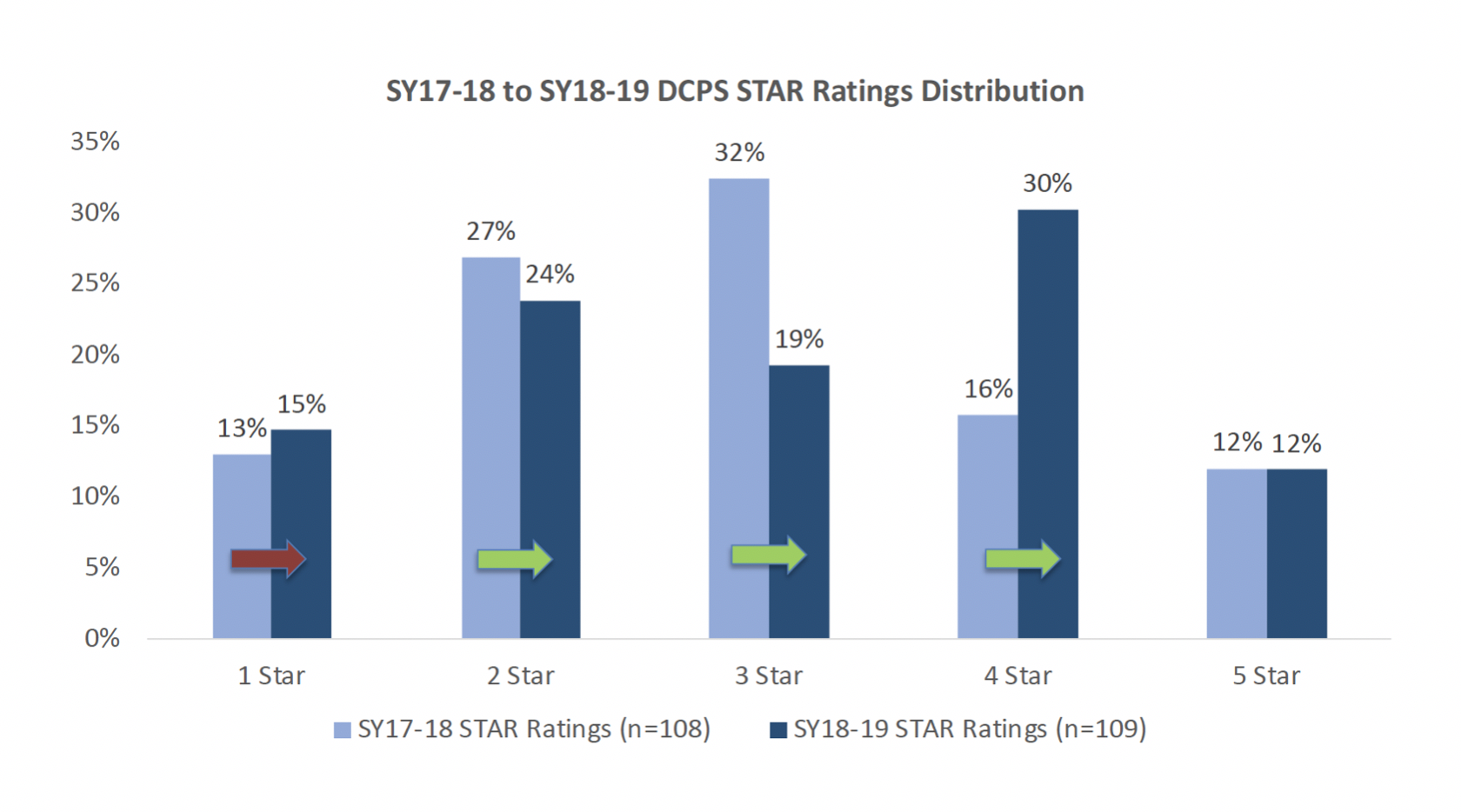(Washington, DC) Today, the Office of the State Superintendent of Education (OSSE) released the DC School Report Card, which includes information about how every public school in the District performed during School Year 2018-2019. The DC School Report Card covers more than 150 data points, including the School Transparency and Reporting (STAR) Framework Rating of overall school performance. Within this framework, schools are rated from 1 to 5 STARs, with 5 being the highest.
“Across DCPS, school leaders are redefining what it means to provide every student with an excellent education, and I am proud that schools across all eight wards received a higher STAR Rating compared to last year,” said DC Public Schools Chancellor Lewis D. Ferebee. “As we celebrate our progress, I also recognize that the results reflect the persistent opportunity gaps that impact our schools and our communities. I want our families, especially our families in Wards 7 and 8, to know that I am committed to providing a great school in every neighborhood at grade level and will continue to work with our school communities to set every DCPS student up for post-secondary success.”
Across all eight wards of Washington, DC, 67 DCPS schools received a 3 STAR Rating or higher, and 34 schools received a higher STAR Rating compared to last year.

Expanding Opportunities for Our Students
The STAR Ratings incorporate school and student performance and are only one metric to evaluate how DCPS schools are setting students up for success on the path to college and career. After four consecutive years of gains on PARCC and a decade of growth on NAEP, DCPS continues to make progress across multiple measures, and looks forward to continuing to build on this progress to ensure that every student attends a great school where they can succeed.
In DCPS’ five-year strategic plan, A Capital Commitment, DCPS committed to increasing the number of excellent schools throughout the district. DCPS recognizes that some of its schools need additional support to accelerate progress and is prioritizing supports and resources to ensure that they are on the pathway to excellence. Community members can access a snapshot of every school’s Comprehensive School Plan on the DCPS website.
This school year, 10 schools became DCPS Connected Schools, which transformed schools into resource hubs in their community to meet our students’ needs inside and outside of the classroom. These schools provide students and families with wraparound services, including family wellness supports, housing, child care, and financial assistance referrals. DCPS also launched the Empowered Learner’s Initiative, taking the first step toward providing every student in grades 3-12 with a technology device over the next three years.
Ballou and Anacostia High Schools in Ward 8, which both received 1 STAR, are currently DCPS Connected Schools and are engaging in a redesign process to transform programming, focus areas, and opportunities that the schools offer. DCPS restructured Central Office supports this school year to focus resources and capacity on the Anacostia and Ballou feeder patterns. DCPS also launched early college programs at Bard DC in Ward 7 and Coolidge High School in Ward 4.
DCPS is committed to expanding equity and excellence across all eight wards, and school leaders continue to provide students and families with the supports they need to grow and thrive. For example:
- Excel Academy (Ward 8), received 3 STARs after its first year operating under DCPS – previously the all-girls charter school was closed. Excel has prioritized empowering young women who may be off-track by developing student success plans to meet their unique needs, and teacher collaboration aligned to DCPS standards.
- Burroughs Elementary School (Ward 5), which received 4 STARs, saw an increase in their STAR Rating as a result of strong instructional practices and their partnership with the Relay Graduate School of Education.
- Sousa Middle School (Ward 7), which received 2 STARs, saw an increase in their STAR Rating as a result of their investments in an interdisciplinary science, technology, engineering, art, and math (STEAM) model. Sousa is also a DCPS Connected School.
- Eliot-Hine Middle School (Ward 6), which received 2 STARs, saw an increase in their STAR Rating due to intentional investments in their educators and increased student supports. Eliot-Hine is also a DCPS Connected School.
- Brookland Middle School (Ward 5), which received 3 STARs, saw a 2-STAR increase through an increased focus on social emotional learning, meaningful investments in family engagement, and prioritizing student growth in English language arts.
- Bancroft Elementary School (Ward 1), which received 5 STARs, saw an increase in their STAR Rating due to targeted interventions for Latino students and English Learners, and providing standards-aligned instruction in all content areas and languages.
DCPS is also focused on keeping equity at the core of its work, empowering schools to provide an excellent education to every child from Pre-K3 through graduation and differentiating supports in order to give every school community what it needs to succeed. Learn more about the STAR Ratings on the DCPS website.
About the DC Report Card and STAR Ratings
Both the report card and accountability framework are requirements for all states under the federal Every Student Succeeds Act (ESSA). OSSE designed the School Report Card to provide families with a range of information, including school points of pride, academic performance, attendance, and each school’s STAR Rating.
The STAR Framework includes multiple areas of school performance, including PARCC results and growth, re-enrollment, chronic absenteeism, and graduation rates, when applicable. These points are totaled for the school overall and for each group of students, including students’ race/ethnicity group, students with disabilities, English learners, and students who meet the city’s definition of At-Risk. The result is the school’s score (up to 100 points) and a rating from 1 to 5 STARs.


